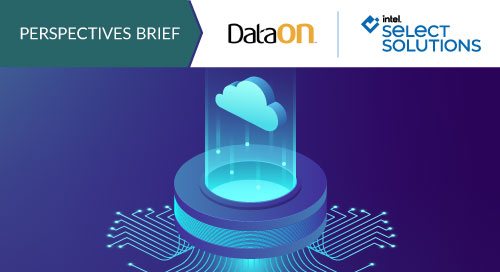How a Museum Transforms Operations with HCI

Like many organizations, the Canadian Museum for Human Rights was rapidly outgrowing its data center. On-premises infrastructure was inadequate for managing ticketing, billing, and hundreds of interactive multimedia displays. Storage closets bulged with mountains of archived tapes, including sole copies of interviews with human rights activists.
Every time the museum wanted to expand anything, it had to buy new hardware, says Howard Lo, vice president of sales and marketing at hybrid cloud computing company DataON. Because growth was unpredictable, the organization sometimes invested in excess capacity that went unused for years.
Working with DataON, the museum created a better solution: a Microsoft Azure Stack hyperconverged infrastructure (HCI) for managing its operations, storage, and disaster recovery.
Azure Stack HCI virtualizes compute, storage, and networking, and unites them on a single platform, easing management and improving performance while adding flexibility and lowering expenses. It shares the same Hyper-V based software-defined compute, storage, and networking as Azure Stack, as well as rigorous testing and validation criteria. Plus, Azure Stack HCI allows you to seamlessly embrace hybrid cloud, connecting your data center to Azure services.
“With Azure Stack HCI, you aren’t tied to a hardware vendor’s requirements,” Lo explains. “You can scale when you need more capacity, and at a much lower cost than traditional SANs or HCI solutions.”
The museum’s operations now run faster and more smoothly. “When ticketing and billing operators tried the new system, their reaction was, ‘Wow!’” says Lo.
Azure Stack HCI also gave the museum agile, inexpensive storage and backup, and created a modern disaster recovery system.
Equally important, the museum’s solution gave it a modern IT architecture that can easily incorporate cutting-edge technologies as they develop (Video 1). “Museum executives now have peace of mind, knowing they have the latest technology and a secure solution they can scale in the future,” Lo says.
Modern HCI solutions can also bring data centers the latest cloud-based capabilities, allowing for easy and continuous innovation. @dataon
Maximizing HCI Performance
To optimize Azure Stack HCI benefits, organizations must start with the right hardware, which is the foundation of virtualization. “Without a great hardware infrastructure, you’re not going to get the most efficient performance,” Lo says.
As an Intel® Select Solutions partner, DataON collaborates with Intel® to develop the hardware components and network connections best suited for a company’s particular workloads. Working closely with the Intel Select team, which pre-validates and pre-certifies its designs, the company can ensure that it delivers the right architecture to customers.
Gaining Access to Innovations
Modern HCI solutions can also bring data centers the latest cloud-based capabilities, allowing for easy and continuous innovation. DataON works exclusively with Microsoft, allowing customers to access its services both through the familiar on-premises tools of Windows Admin Center and through Azure Stack HCI.
“Microsoft developed a solution for both the on-premises environment and the cloud so that companies can make transitions seamlessly across the two,” Lo says. “With Azure Stack HCI, you get all the resiliency, performance, and bandwidth you need, and you can take advantage of Azure services like virtual desktop infrastructure or Kubernetes.”
And with Microsoft’s new Kubernetes Service on Azure Stack HCI, companies manage workloads on premise—requiring fewer resources and making operations more efficient. Data centers often use hundreds of VMs to run applications, and each VM consumes compute and memory resources. With Kubernetes, applications are orchestrated in containers that include multiple VMs. Containers can be shared across workloads and departments without requiring any additional compute or storage capacity.
Flexible Services and Cost Control
Another way Azure Stack HCI makes a big difference to data centers is by providing better options for storage and disaster recovery.
For example, to accommodate the museum’s enormous storage needs, DataON’s Azure Stack HCI solution created four petabytes of Azure-based storage. Obtaining similar on-site capacity without it would have entailed hardware replacement, maintenance fees, and other expenses, costing the organization four times more, according to DataON.
Azure Stack HCI provides a similar solution for disaster recovery, which is prohibitively expensive for many organizations. “With traditional data center architecture, if you want a disaster recovery option, you need to build another data center,” Lo says.
Instead, DataON simply copies an organization’s Azure Stack HCI work functions into low-cost Azure storage and enables Azure’s site recovery service. “If your on-premises infrastructure fails, you can run your entire business off of the Azure cloud,” says Lo.
Companies with more than one location can use a different Azure service, allowing them to “stretch” workloads across two physical sites. If one site goes down, the other takes over. “This capability could cost millions of dollars with a traditional data center infrastructure,” says Lo.
Data Center Monitoring
Azure Stack HCI can also make life easier for IT administrators with Windows Admin Center and DataON MUST. Windows Admin Center is a locally deployed, browser-based management tool that lets you manage Azure Stack HCI and Windows Server systems. It combines with DataON’s MUST extension for Windows Admin Center to provide centralized data center monitoring, management, and alerts from a single console. MUST adds to the Windows Admin Center experience with features such as historic data reporting, disk mapping, system alerts, alert services, call home support, and an inventory management tool.
Email alerts allow IT to monitor on-site infrastructure remotely. “If you’re sitting at home, you’ll get an email saying, ‘Server node number two, drive number three isn’t doing well—make sure you check on it when you get in,’” Lo says.
A Customized HCI Future
As workload requirements for compute, networking, and bandwidth explode, organizations can’t resort to a traditional IT architecture. Lo believes more companies will be turning to HCI to accommodate growing needs.
“Businesses are looking for ways to reduce their costs and increase performance. Azure Stack HCI offers the best way to optimize workloads and scale incrementally. By working with DataON and its partners Intel and Microsoft, companies can ensure they have the right architecture based on their business requirements as they grow.”